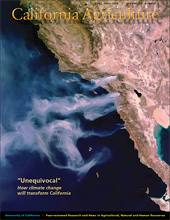California, USA
April 9, 2009
Earth’s temperature has risen 1°F
in the last 100 years -- a small number with a profound impact
for California. According to scenarios developed by the
Intergovernmental Panel on Climate Change (IPCC), our planet
will heat up another 1°F to 2.3°F by 2034 -- an accelerating
change that will take place over the course of just 25 years,
rather than 100.
In its 2007 report, the IPCC concluded that, "Warming of the
climate system is unequivocal, as is now evident from
observations of increases in global average air and ocean
temperatures, widespread melting of snow and ice, and rising
global mean sea level."
 The
entire April-June 2009 issue of University of California's
California Agriculture journal is devoted to news and research
on climate change and how it will fundamentally alter
California’s environment and landscape, agriculture and food
quality. The issue is available online:
http://californiaagriculture.ucop.edu/0902AMJ/toc.html. The
entire April-June 2009 issue of University of California's
California Agriculture journal is devoted to news and research
on climate change and how it will fundamentally alter
California’s environment and landscape, agriculture and food
quality. The issue is available online:
http://californiaagriculture.ucop.edu/0902AMJ/toc.html.
"California's warmer winters and springs have led to reduced
snowpack, increasing the seasonality of water flows and directly
affecting our ability to grow plants, produce food and support
growing populations," wrote Barbara Allen-Diaz, UC assistant
vice president for agriculture and natural resources (ANR), in
the journal's opening editorial. "Wildfires are increasing; crop
pests are expanding their ranges. 'Natural disasters' -- such as
droughts, Santa Ana winds, tornados, higher intensity rainfall
events and fire -- are more frequent and severe."
California's $37 billion agricultural industry will be severely
affected by the coming changes.
"Recent and predicted increases in temperature will have major
impacts on where plants can be grown. Changing temperatures will
also likely shift the range of native plants, and even cause
some to disappear altogether," wrote Allen-Diaz, who shared the
2007 Nobel Peace Prize with about 2,000 IPCC scientists and
former Vice President Al Gore.
The April-June 2009 issue of California Agriculture journal
includes the following peer-reviewed research findings:
- UC Davis meteorologist
Bryan Weare, faculty chair of the special issue, reviews the
science behind the IPCC's comprehensive 2007 reports and
summarizes the predicted changes to California's climate,
weather, growing conditions, pollution, sea level and other
factors.
- New research by UC Davis
plant scientist Arnold Bloom suggests a mechanism to explain
why initial increases in crop production due to "CO2
fertilization" decline rapidly, a finding with important
implications for hunger and nutrition worldwide.
- A review by UC Riverside
entomologist John Trumble and graduate student Casey Butler
predicts that the numbers and kinds of invasive insect pests
will increase because of rising temperatures. Pest insects
will consume more of certain plants due to their higher
carbon and lower nitrogen content, and the reduction in
winter chill periods will allow pests to breed throughout
the year.
- A controlled chamber study
by UC Davis associate professor Frank Mitloehner and
colleagues measures the actual emissions of greenhouse gases
by dairy cows.
- Computer modeling by UC
Davis economists and colleagues demonstrates how alternative
agricultural practices such as cover cropping can have a
significant impact on the amounts of greenhouse gases
emitted from fields.
- UC Davis economist Richard
Howitt and colleagues conduct a survey of Yolo County
growers and develop an economic model to identify
sustainable fertilization practices, proposing incentives
for farmers to incorporate carbon sequestration into
everyday practice.
- In a review of carbon
trading, UC Davis economists Deb Niemeier and Dana Rowan
discuss how global carbon markets are evolving as tools to
reduce greenhouse-gas emissions.
California Agriculture is the
University of California's peer-reviewed journal of research in
agricultural, human and natural resources. For a free
subscription, go to:
http://californiaagriculture.ucop.edu, , write to
calag@ucop.edu or call
(510) 642-2431 x33. |
|